
Strawberries in a hot climate: Strawberries are a choice crop for many small farms in California's central valley who operate roadside farmstands and u-pick (aka "pick-your-own") for direct sales to customers, but the hot climate of the valley poses some challenges very different from cooler regions where most strawberries are grown commercially. Spider mites are pests of strawberries just about everywhere, but the heat and dry conditions that mark the climate of the valley favor spider mites and can result in a very quick increase of this pest from barely noticed to catastrophic. Regular scouting needs to be a mainstay for keeping on top of this tiny but formidable pest. Scouting can discover when mites are active and indicate the right time for an effective control application.
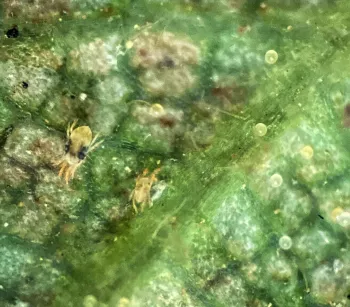
What are spider mites and how do they damage strawberries? Spider mites are minute arachnids (related to ticks, and more distantly to spiders), not visible to the unaided eye, that feed on a wide range of plants, including most crops. In fact, the hot, dry summer of 2024 made it a terrible spider mite year for many trees in the San Joaquin Valley, including eastern Contra Costa County. There are several different species of spider mites in California, but the species that mostly occurs in our region is the two-spotted spider mite (scientific name, Tetranychus urticae), distinguished by two dark spots, one on each side a mature adult's body. They feed on the underside of leaves by piercing the cells of the leaf surface and sucking out the contents. In a slow death by a thousand stabs, leaves fed on by a large number of mites show numerous flecks (called stippling) and eventually begin to turn a bronze color, sometimes also reddening. This damage can substantially weaken plants and compromise the harvest. Visible webbing indicates a severe outbreak.
How can spider mites be managed? Spider mites are favored by dry, dusty conditions, as they typically blow into fields with dust. Reducing dust can go a long way toward reducing pressure. They also thrive under hot conditions and on stressed plants, circumstances that often occur together, so adequate irrigation is important. Additionally, day neutral varieties are considered more susceptible, especially when they have had inadequate chilling. Good chilling promotes vigor and resistance to mites, but may reduce productivity, so it is a balancing act. Chemical control of spider mites can be tricky. Given their rapid reproductive ability, resistance to miticides is known to happen quickly. Rotating active ingredients is essential. Broad-spectrum insecticides can eliminate beneficial insects, which can keep spider mites and other pests at potentially tolerable levels.
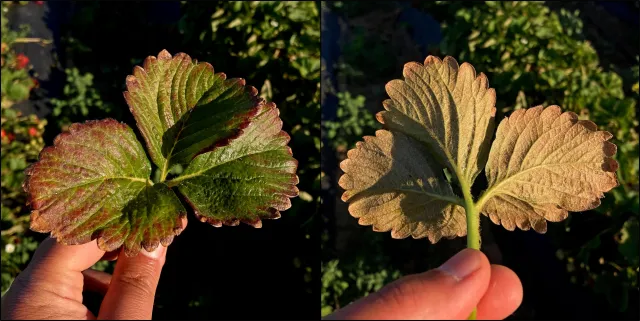
The good news (biocontrol): Fortunately, in fact, many beneficial insects and arthropods feed on spider mites. Some of the most effective are mites themselves. These species of predatory mites include several that are used regularly as commercially available products for augmenting biocontrol (short for "biological control") in commercial outdoor production. Phytoseiulus persimilis is a predator that feeds exclusively on spider mites and applying this biocontrol agent to fields is a mainstay of integrated management of this pest in coastal strawberry production where milder temperatures favor it. Neoseiulus californicus is considered more tolerant of warmer
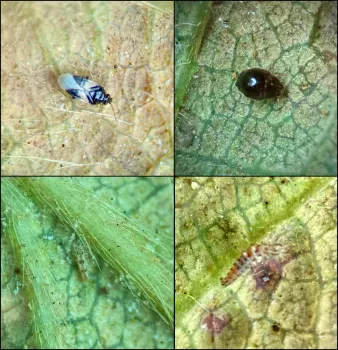
temperatures and lower humidity. Another species, the western predatory mite (Galendromus occidentalis) which is native to the western North America, is increasingly being offered by insectaries. It is unclear how well these biocontrol agents might work in hot, inland climates. In preliminary trials, we have not found much indication of success. However, with increasing interest in sustainable pest management, many growers are interested to learn more about potentially controlling spider mites without pesticides. Other predators of spidermites include minute pirate bug (Orius tristicolor), Spider Mite Destroyer (Stethorus picipes), and lacewings.
Our research on biocontrol: Last year, I started a collaboration with the Community Alliance for Family Farmers (CAFF) Ecological Pest Management team to begin developing methods to test out biocontrol in central valley small scale strawberry farms. The 2025 season turned out to be (in stark contrast to 2024) a mild spider mite season, but there were a few observations to guide next year's activity.
A key part of the learning curve has been learning to scout effectively and to quantify spider mite pressure. Pest management recommendations are to collect 5 to 10 leaflets per acres or small block with an control recommended when an average of 10 mites per leaflet are found for the summer transplants during the first four months of growth. During harvest, control is recommended only when 15 to 20 mites are found per leaflet (with the caution that results can vary with the numerous variables of production). I adapted this recommendation to a rating on a scale of 0 to 3 to rate symptom severity, spider mite numbers, and egg numbers individually. (A table describing the rating system follows at the end of the post).
To take a case at one site (figure 1), the variety Monterey was more affected by spider mites early in the season than Albion, but other factors, including exposure to a tilled field nearby may have played a part. More significantly, the severity of symptoms did not always match the spider mite pressure. The persistence of symptoms on the Monterey plants for a while after spider mite populations dropped off shows the need for continued scouting to confirm active pest populations on symptomatic plants. We monitored for beneficial insects using yellow sticky cards in the blocks, and interestingly, spider mite pressure began to decline on May 23 when beneficial insects were also first detected in the block (figure 2, site A). In general, the number of beneficial insects caught on cards really picked up in late may. This suggests that augmenting biocontrol will likely be important earlier in the season. We should keep in mind that this was a very mild year that did not especially favor spider mites.
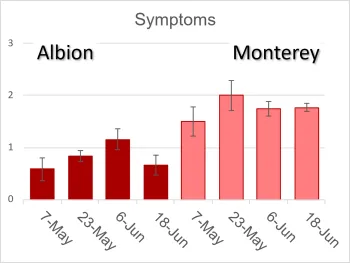
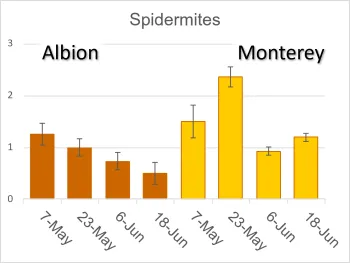

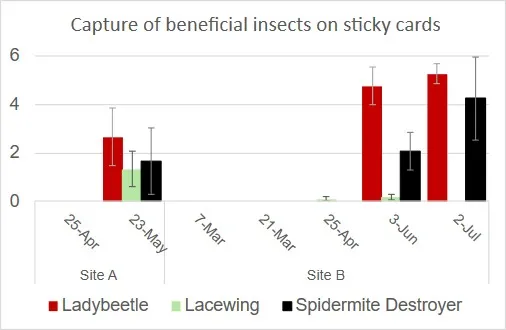
If you produce strawberries in Alameda or Contra Costa county and are interested in learning more about spider mite management and biocontrol, or to share your experience in managing these pests, please reach out. Look for more information on managing spider mites on strawberries as this projects develops.
Rating system:
| RATING: | 0 | 1 | 2 | 3 |
| Symptoms | Leaf effectively completely clean & bright green | Slight discoloration (entire leaf) and/or reddening around leaf edges but <1/3 leaf affected | Obvious bronzing of >2/3 leaf area and/or puckering and edge curling but little to no webbing | Severe bronzing of nearly all leaf area, significant puckering & edge curling, signs of webbing |
| Mite & Egg Counts | none seen | in general, fewer than 10 mites or eggs seen at a time, mites/eggs on less than 1/3 of the leaflet | in general, >10 mites or eggs seen at a time and on more than 1/3 of the leaflet | in general, >10 mites or eggs seen at a time and on more than 2/3 of the leaflet |
Sources and References:
Spider mites and their management in strawberries by Surendra Dara, UC Cooperative Extension

